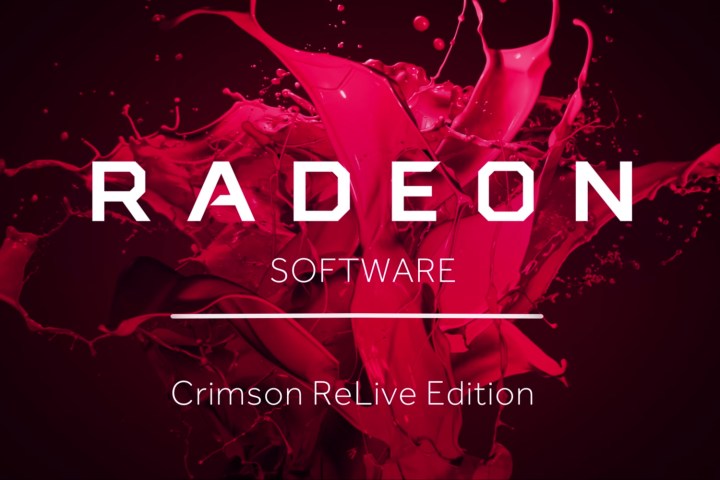
With this version of AMD’s new Radeon software, the company focuses on three key areas: features, performance, and stability. For the features aspect, AMD said it streamlined the Radeon Settings interface by moving everything into a single panel. Now there are less clicks to make, plus AMD says the software also includes switchable graphics, and better control over pixel format and color depth.
Radeon ReLive
A major feature in the latest Radeon driver update is an upgrade to Radeon ReLive. As we’ve seen over the last six months, the company managed to hack away at the lengthy list of issues surrounding its game-streaming software since its launch, and reduce the issues down to just several. In the process, AMD increased the maximum recording bitrate to 100Mbps, up from 50Mbps, for a clearer broadcast. There’s also now a transparency option for the camera, so your mug doesn’t completely block all the action underneath.
If that wasn’t enough, AMD enhanced Radeon ReLive for better memory optimization while recording. For instance, AMD reports up to 33 percent less frames per second overhead in Call of Duty: Infinite Warfare. With v17.7.1 of the driver, the game had an average overhead of 6.3 frames per second. With the new Radeon driver update, the average overhead is only 4.2 frames per second. That essentially means AMD reduced amount of additional frames needed to render overlays while keeping the output at a steady framerate.
As for other Radeon ReLive enhancements, AMD refined the notification system, such as by adding an “Instant Replay Saving” card, a network connectivity issue card, and more. It now has advanced audio controls, too, such as customized microphone and volume levels, a microphone push-to-talk feature used by a mouse or keyboard, and an audio volume boost.
Radeon WattMan
Moving on from Radeon ReLive, the new Radeon drive update includes an updated Radeon WattMan utility. Here users can now underclock (slow down) the memory installed on Radeon graphics cards so they can safely overclock the system’s processor without affecting the PC’s stability and overall power usage. Radeon WattMan provides settings for controlling the GPU’s power states, too, for maximum performance or maximum power savings.
Radeon Chill
Radeon Chill, a power-saving feature that can dynamically regulate a game’s framerate based on in-game movement, now supports game profiles. The feature is now supported by more than 30 PC games to date, providing up to 31 percent less average GPU power in watts when playing World of Warcraft, and up to 13 percent lower average GPU temperatures in the same game. Other supporting titles include Prey, Quake Champions, Battlefield 1, Mass Effect: Andromeda, Resident Evil 7, and more.
However, the big news with Radeon Chill is that it now supports multi-GPU configurations, providing up to 29 percent lower average GPU power usage in watts in Overwatch. This feature also now supports external graphics cards relying on Radeon XConnect, and supports Radeon graphics in notebooks (integrated and discrete). According to AMD, this feature provides up to 30 percent longer laptop battery life while playing League of Legends at 1080p.
Backing Radeon Chill is a feature called Frame Rate Target Control. Serving as a means of power optimization, this feature promises a power savings of up to 26 percent when playing Battlefield 1 with DirectX 12 enabled. With the feature turned on, the game can still manage 60 frames per second while the GPU consumes only 150 watts of power. With the feature off, the GPU consumes 203 watts.
Enhanced Sync
This new feature isn’t meant to replace AMD’s FreeSync technology, but to provide a better viewing experience for those without a supporting display. It resides between VSync and FreeSync, providing deceased stutter and an occasional tearing at 60 frames per second on a 144Hz monitor. It also provides a low latency for minimal screen tearing at framerates of 150FPS or more.
For example, with VSync on, the response time can be around 128.8 milliseconds when the frame rate is higher than a panel’s refresh rate, causing minimal screen tearing. With Enhanced Sync, that response time speeds up to 84.7 milliseconds while still maintaining minimal screen tearing. If you turn VSync off, then the response time jumps up to 72.7 milliseconds, but you’ll see loads of annoying screen tearing. Adding to that, Enhanced Screen provides an even, low-stutter visual field when frame rates fall below the monitor’s refresh rate. With VSync enabled, the stuttering can be rough.
And on to the Backend
Finally, AMD did a lot of work on the backend, too. The company has increased the performance of its Radeon driver update since the launch of Crimson ReLive Edition, and increased the performance of games like Deus Ex: Mankind Divided and Metro Last Light Redux running on Linux. AMD also figured out a way to speed up the load times of older PC games like StarCraft 2, and reduce the driver frame wait-times between the CPU’s command to draw a frame, and the GPU’s final rendered frame.
According to AMD, moving the mouse in Prey and seeing the resulting action on-screen takes a mere 100 milliseconds, down from 111 milliseconds in v17.7.1 of AMD’s Radeon driver software. Mass Effect: Andromeda is now at 114 milliseconds (down from 131 milliseconds), and Tom Clancy’s The Division is now at 112 milliseconds, down from 162 milliseconds. For Honor is now at 130 milliseconds, down from 146 milliseconds.
Another notable feature in AMD’s new Radeon driver update is a tool for developers called Radeon GPU Profiler. This tool enables low level, built-in hardware thread tracing, which previously was only served up to AMD’s console developers. This is good news for PC gamers because developers can now trace their code to specific hardware events to better squash bugs and optimize performance. Developers get a clear visualization of what’s going on through wave-based graphs.



